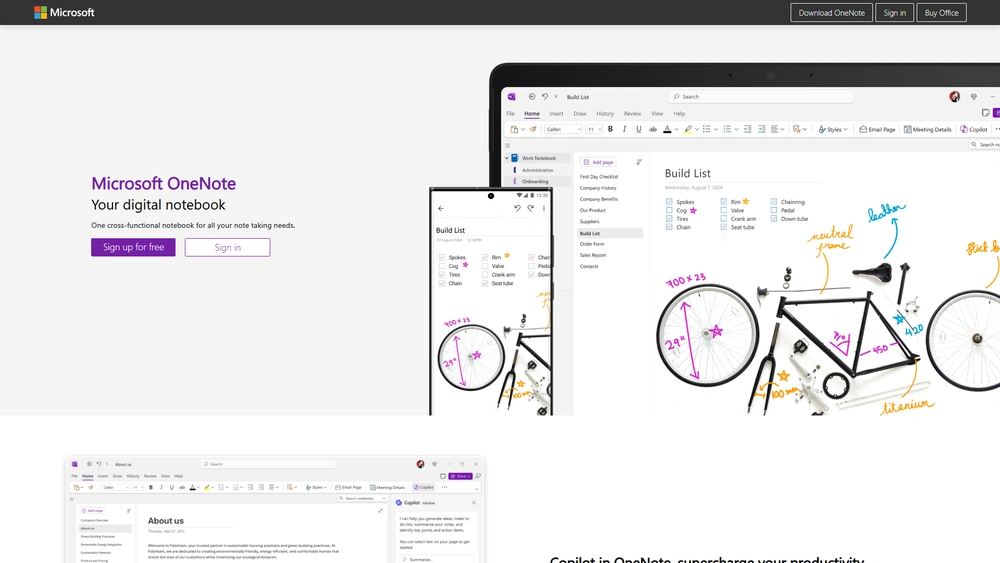Microsoft OneNote Overview & 2026 Industry Position
Microsoft OneNote continues to dominate the note-taking landscape as a versatile, collaborative platform for individuals and teams. Designed for capturing, organizing, and sharing ideas seamlessly across devices, OneNote has matured into a vital productivity component within Microsoft’s broader 365 ecosystem. In 2026, it stands out due to its advanced integration with AI-powered tools, enhanced cross-platform consistency, and focus on real-time collaborative workflows, meeting the demands of hybrid teams and digital-first users.
From Launch to 2026: Microsoft OneNote’s Journey
Launched in 2003, Microsoft OneNote was originally developed to provide users with a digital notebook alternative. Key milestones in its evolution include:
- 2007: First integration with Microsoft Office Suite.
- 2014: OneNote becomes free across all platforms.
- 2016: Deep integration with Office 365 and Microsoft Teams begins.
- 2020: Major UI/UX redesign for greater accessibility and mobility.
- 2023: Introduction of AI-powered Note Summarizer and Task Tags.
- 2025: Complete synchronization across all platforms using Fluid Framework for live-editing and embedded collaboration.
In 2026, Microsoft OneNote’s strategic focus centers on seamless knowledge capture that’s AI-enhanced, collaborative, and natively networked through Microsoft Copilot and 365 powers.

Microsoft OneNote Key Features
OneNote’s core features place it in a class of its own for digital note-taking experiences. Here’s what makes Microsoft OneNote compelling in 2026:
- Multi-format Note Capture: Text, handwriting, voice, video clipping, and file attachments.
- AI Copilot Assistance: Uses Microsoft Copilot to summarize notes, create smart to-do lists, and generate action items.
- Real-Time Collaboration: Simultaneous editing with change tracking and contributor highlights.
- Tagging & Search: Smart Tags, OCR-powered image search, and semantic rankings.
- Flexible Organization: Sections, pages, and nested notebooks for all use cases.
- Offline Support: Full access with background sync across devices.
- Templates: Meeting notes, class outlines, journaling formats, and more.
Workflow & UX
Microsoft OneNote’s design prioritizes clarity and flexibility. The 2025 interface is flatter, faster, and easier to navigate across web, desktop, and mobile apps.
- Drag-and-drop interface: Move sections and pages with ease.
- Device parity: Consistent UI and offline access on Windows, macOS, iOS, Android, and browser.
- Dual-display support: Great for educators and business use with live projection and editing.
- Accessibility enhancements: VoiceOver, screen readers, and keyboard-only navigation fully supported.
Pro Tip: Use page linking and collapsible outline headers to create wiki-style knowledge bases within your notebooks.
Microsoft OneNote Pricing Analysis & Value Metrics
| Plan | Price | Included Features |
|---|---|---|
| Free | $0 | Basic editing, apps for all devices, 5GB OneDrive |
| Microsoft 365 Personal | $6.99/month | 1TB storage, Copilot AI, advanced collaboration, offline sync |
| Microsoft 365 Family | $9.99/month | All personal features for up to 6 users |
| Microsoft 365 Business Standard | $12.50/user/month | Business-grade IT controls, full Office suite, Teams integration |
| Education | Free* | *For eligible institutions and students |
Value Verdict: With Copilot now included in Personal and Business plans, Microsoft OneNote offers one of the highest ROI solutions in its category for 2026.
Competitive Landscape
How Microsoft OneNote stacks up against alternatives in 2026:
| Tool | Strengths | Weaknesses | Best for |
|---|---|---|---|
| Notion | Customization, databases, workspace creation | Steep learning curve, inferior collaboration speed | Project managers, teams building shared hubs |
| Evernote | Clipping, web capture, legacy user base | Subscription cost, UI stagnation | Writers, researchers, solo users |
| Apple Notes | Seamless on macOS/iOS, simplicity | No non-Apple sync, fewer power features | Apple ecosystem users wanting simplicity |
Common Use Cases
Microsoft OneNote excels across industries and use styles:
- Education: Lecture capture, study guides, reading notes.
- Corporate: Meeting records, SOP templates, work journals.
- Creative: Planning story arcs, moodboards, design logbooks.
- Entrepreneurship: Business plans, pitch decks, journaling future backlog.
Microsoft OneNote Integrations
OneNote unlocks deeper functionality through its integrations:
- Microsoft Teams – Live notebook sharing during meetings
- Outlook – Convert notes to calendar events or emails
- Copilot – AI-driven insight from shared notes
- Planner & To Do – Task linkage and sync across apps
- Third-party connectors: Trello, Slack, Zoom, Asana
Pros & Cons
- ✔ Robust collaboration and AI features
- ✔ Excellent cross-platform parity, including offline sync
- ✔ Incredibly strong value within Microsoft 365 bundles
- ✖ Somewhat steep learning curve for non-Microsoft users
- ✖ Overwhelming for users seeking minimal interfaces
- ✖ Shared notebooks require Microsoft account coordination
Final Thoughts
Microsoft OneNote remains one of the most powerful note-taking solutions in 2026 thanks to deep AI integration, full-featured cross-platform support, and excellent value within the Microsoft 365 stack. It’s ideal for teams, corporate users, students, and professionals who want seamless collaboration, detailed organizational tools, and new-gen planning capabilities. While the learning curve may challenge minimalists or non-365 users, the overall capabilities justify the adoption.
Microsoft OneNote FAQ
Yes, all OneNote apps offer offline access and sync changes once reconnected to the internet.
Yes, OneNote offers a completely free version across platforms, with premium features available via Microsoft 365 subscriptions.
Absolutely. OneNote notebooks can be integrated directly into Teams channels for real-time note sharing and collaboration.
Yes, OneNote supports handwriting input, drawing, and ink-to-text conversion on touch-enabled devices.
OneNote follows Microsoft 365’s enterprise-grade security, including data encryption, MFA, and tenant-based access control.